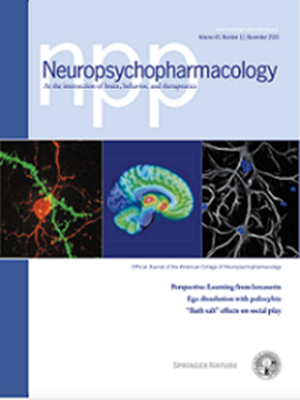VTA-ACC dopaminergic circuit mediates trait anxiety-related observational learning of social avoidance in male mice
IF 6.6
1区 医学
Q1 NEUROSCIENCES
引用次数: 0
Abstract
Social animals encounter both environmental and social stress, yet the mechanisms by which individuals with different levels of trait anxiety cope with these stressors, as well as the neurobiological links between trait anxiety and social cognition, remain incompletely understood. Here, male mice are classified into high-trait anxiety (HTA) and low-trait anxiety (LTA) groups based on their anxiety responses to elevated platform exposure in the open field test. Under observational learning-based vicarious social defeat stress (VSDS), HTA mice exhibit less social avoidance behavior toward CD1 aggressors than LTA mice. Fiber photometry reveals that HTA mice display higher activity of ventral tegmental area (VTA) dopaminergic (VTADA) neurons during environmental stress, while LTA mice exhibit greater VTADA neurons activity under social stress. Viral tracing identifies the connectivity of VTADA neurons and anterior cingulate cortex (ACC). Optogenetic and chemogenetic manipulations demonstrate that VTA-ACC dopaminergic circuit is necessary and sufficient for VSDS-induced social avoidance behavior in HTA and LTA mice. RNA-sequencing suggested that VTA neuroinflammatory signaling may be a key factor contributing to the difference between HTA and LTA mice. Thus, this study reveals a neural circuit mechanism for trait anxiety-related observational learning of social avoidance behavior in male mice, and provides a molecular mechanism in shaping trait anxiety.

VTA-ACC多巴胺能回路介导雄性小鼠特质焦虑相关的社交回避观察性学习。
社会动物既会遇到环境压力,也会遇到社会压力,但不同程度特质焦虑个体应对这些压力源的机制,以及特质焦虑与社会认知之间的神经生物学联系,目前还不完全清楚。在这里,雄性小鼠根据其在开阔场地测试中对高平台暴露的焦虑反应分为高特质焦虑(HTA)组和低特质焦虑(LTA)组。在基于观察性学习的替代性社会失败应激(VSDS)下,HTA小鼠对CD1攻击者的社会回避行为比LTA小鼠少。纤维光度法显示,环境应激下HTA小鼠腹侧被盖区(VTA)多巴胺能(VTADA)神经元活性较高,而社会应激下LTA小鼠VTADA神经元活性较高。病毒追踪鉴定VTADA神经元和前扣带皮层(ACC)的连通性。光遗传学和化学遗传学操作表明,VTA-ACC多巴胺能回路在vsds诱导的HTA和LTA小鼠社会回避行为中是必要和充分的。rna测序提示VTA神经炎症信号可能是导致HTA和LTA小鼠差异的关键因素。因此,本研究揭示了雄性小鼠与特质焦虑相关的社交回避行为观察学习的神经回路机制,并提供了特质焦虑形成的分子机制。
本文章由计算机程序翻译,如有差异,请以英文原文为准。
求助全文
约1分钟内获得全文
求助全文
来源期刊

Neuropsychopharmacology
医学-精神病学
CiteScore
15.00
自引率
2.60%
发文量
240
审稿时长
2 months
期刊介绍:
Neuropsychopharmacology is a reputable international scientific journal that serves as the official publication of the American College of Neuropsychopharmacology (ACNP). The journal's primary focus is on research that enhances our knowledge of the brain and behavior, with a particular emphasis on the molecular, cellular, physiological, and psychological aspects of substances that affect the central nervous system (CNS). It also aims to identify new molecular targets for the development of future drugs.
The journal prioritizes original research reports, but it also welcomes mini-reviews and perspectives, which are often solicited by the editorial office. These types of articles provide valuable insights and syntheses of current research trends and future directions in the field of neuroscience and pharmacology.
 求助内容:
求助内容: 应助结果提醒方式:
应助结果提醒方式:


